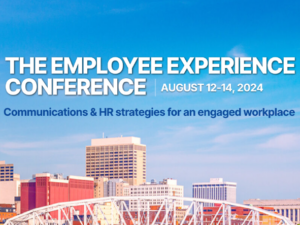Hacks for a healthy hybrid workplace
Strategies for boosting employee engagement and satisfaction.

During Ragan’s Internal Communications Conference at Microsoft HQ in Seattle this past fall, Ragan editor Sean Devlin moderated a coveration with Alison Zurcher, director of internal communications at Seattle Children’s Hospital and Janine Narvali, head of business development at Appspace about how communicators can nurture a hybrid workplace where employee engagement and satisfaction are a top priority.
Here’s what we learned.
- Get creative with prioritizing existing people, tools and technology.
Narvali began by emphasizing how much a successful hybrid workforce depends on your tech stack being optimized for both work-life balance, working from home, in the office and investing in your people — which means measuring their engagement to tie it back to ROI.
Zurcher was candid in explaining how a lack of capital for the newest tools and tech required her to make the most of the things still at their disposal. Partnering with the IT department to determine what was available to them meant getting scrappy and creative. Narvali agreed, and stressed the HR collaboration as key here, too.
Narvali agreed, and stressed the HR collaboration as key here, too. “If you can think about working with your counterparts within HR, understanding what tools and technologies already exist within your company, then leveraging those and potentially your outputs or external communications,” she said.
Identifying those change agents across the company to determine how you can operationalize existing tech, added Narvali, will also reveal when you need to start looking for new solutions.
- Mandate a purposeful number of RTO days.
Asked what she considered to be the sweet spot of RTO days, Zurcher brought it back to driving a desired behavior—in this case, getting employees to want to come back. The best way to do this, she said, is by defining the purpose of RTO at the outset.
“It can’t just be to have a warm body in a seat,” she said, explaining why her marketing and communications team committed to come into the office two days a week. “The intention behind that is in-person collaboration, living our mission and our vision.”
Because Wednesdays have traditionally been Seattle Children’s all-staff meeting days, which stress dialogue and collaboration, this is when leadership decided coming into the office made sense for everyone. Zurcher’s team also has its own meeting on Tuesday, so comms and marketing come into the office on those two days.
Spreading out 1:1s with her colleagues across those two days gives utility and purpose to the time invested in coming in.
- Audits are a must.
You won’t know what those effective or unengaged tools are unless you conduct regular audits of your communications channels and capabilities. Zurcher’s tips for effective audits include:
- Defining internal benchmarks. Set regular internal comms audits, with pulse checks that benchmark engagement before, during and after a change event.
- Pay an external agency to conduct an audit if you’d like to benchmark your engagement against industry competitors.
- Back assumptions with data. Combat “nobody” and “everybody” type assumptions from leaders by tying insights back to what your pulses are telling you.
- Design an engagement calculator.
Zurcher explained how storytelling can bridge the gap between in-office and remote days to keep the hybrid workforce engaged. To that end, her team designed an engagement calculator that measures the effectiveness of each story it shares. The grid includes columns for hits/views, likes, shares, comments, word count, average read time in seconds, read time ratio and engagement score.
“We had all these other data points, and we thought there had to be a more robust way to help inform us, as a team, of what people were truly engaging with,” she said.
Working with the data science team, they designed the engagement calculator to weigh data points differently and determine an overall engagement score. Zurcher’s team takes the past two years of that data and buckets it into a range— top-tier range stories are green, lower range stories are red.
“It’s helped us see what stories people are engaging with, and what stories we could maybe tell in a different way,” she said.
Check out the full conversation here:






